Love is Eternal
- "Life - it's instant.
Honor, triumph, wealth and science - are transient. All the temptations of life
go away. We can only Love is Eternal - the cause of every good deed. Love that
will outlive us. After all, God is Love. The main thing - Love the Truth. Be
who you are: without pretense, without fear and without looking back. If Truth
is your persecution - accept it if is suffering - they endure. If for the sake
of Truth you have to sacrifice themselves and their lives - be strong in
self-sacrifice. Death - it's not the end but the beginning. "


Saint Giuseppe Moscati

The life of every individual is
created in the image and likeness of God, and is therefore sacred and invioable
from conception to natural death…

Saint Giuseppe Moscati (July 25, 1880 – April 12, 1927) was an Italian doctor, scientific researcher, and university professor noted both for his pioneering work in biochemistry and for his piety...

Moscati's
house in Benevento
Moscati was canonized by the Roman Catholic Church in 1987; his feast day is November 16...


Francesco Moscati, Saint’s father Rosa De Luca, Saint’s mother
Seventh of nine children born to a prominent family, the
son of Francsco Moscati, a lawyer and magistrate who served as an altar server
whenever possible, and Rosa de Luca dei Marchesi di Roseto, whose family was
Italian nobility. ..

Alberto, Moscati's brother
Giuseppe’s family moved to Naples, Italy when the boy was
four years old; he made his First Communion at age eight, Confirmation at ten.
Friend of Blessed Bartolo Longo and Blessed Caterina Volpicelli...

The young Moscati, standing near his sister Nina

... his sister Nina
Received his
doctorate from the University of Naples in 1903...

Worked at and served as
administrator of a hospital for the incurable while continuing to study and do
medical research...

The Anatomy Lab in the Incurabili Hospital,
with the Crucifix and the plaque placed there
by Professor Moscati.
Assisted in the preparation for and recovery from the
eruption of Mount Vesuvius on 8 April 1906, but refused any recognition for the
work. Led the work to stop cholera in Naples...

Academic year 1923: Saint Joseph Moscati in a group photo
Member of the Royal Academy of
Surgical Medicine in 1911, and received a doctorate in physiological chemistry...

Saint Joseph Moscati in 1923
Directed several hospitals and medical societies, and was one of the first to
experiment with the use of insulin for diabetes...

Bronze statue of the Virgin of the Silence belonged
St.Joseph Moscati
Tried to enlist in the army in
World War I, but was refused and instead ran a hospital for the wounded;
personally treated almost 3,000 soldiers. He healed (sometimes miraculously),
taught at numerous universities and hospitals, and supported the poor and
outcast; could sometimes diagnose a patient‘s illness and prescribe for it
without having seen the patient. Knew when and how to use a patient‘s faith and
the sacraments to effect a cure. First modern physician to be canonized...

The entrance of Incurabili Hospital
Not often is someone with a
professional degree from a modern secular university declared a saint.
Moreover, it is positively earth-shattering when an internationally acclaimed
scientist becomes a certified miracle-worker...

St.J.Moscati’s Crucifix
The life of St. Giuseppe Moscati
illustrates how the Catholic faith and practical charity united a layman with
God to such an extent that the power of God ultimately worked in and through
him…


Prof.Moscati, in the Incurables Hospital of Naples,
during "Great War" 1915-1918
Giuseppe Moscati was the seventh of
nine children born to aristocratic Italian parents. His father's career as a
magistrate (judge) led the family to settle in Naples province of Avellino

Picture of Our Lady of Pompei, in Prof. Moscati’s study
The future saint inherited his
father's piety and intellectual gifts. Giuseppe's unexpected decision to study
medicine rather than law can be traced to an incident during his adolescence.
In 1893 his older brother Alberto, a lieutenant in the artillery, fell from a
horse and sustained incurable head trauma. For years Giuseppe helped care for
his injured brother at home, and as he matured he reflected on the limited
effectiveness of human remedies and the consoling power of religion…
Giuseppe Moscati regarded his
medical practice as a lay apostolate, a ministry to his suffering fellowmen.
Before examining a patient or engaging in research he would place himself in
the presence of God. He encouraged his patients, especially those who were
about to undergo surgery, to receive the sacraments…

Studio of Doctor Moscati
"The holy physician of Naples

Prof.Moscati among his students
On a Tuesday in 1927, Giuseppe
Moscati went to Mass and received Holy Communion (as he did every day) and then
made his rounds at the hospital. After a midday meal he felt weary, lay down,
and died peacefully. He was not yet 47 years old…
Giuseppe Moscati was beatified in
1975 and declared a saint by Pope John Paul II on October 25, 1987. His feast
day is November 16…

The Incurabili hospital militarised during the First
World War. Starting from the left, among the physicians, Joseph Moscati is the
third one
The miraculous power of the holy
physician's intercession in heaven is explained by his conscientious practice
of Christian charity while on earth. As he wrote to a colleague, "Only one science
is unshakeable and unshaken, the one revealed by God, the science of the
hereafter! In all your works, look to Heaven, to the eternity of life and of
the soul, and orient yourself then much differently from the way that merely
human considerations might suggest, and your activity will be inspired for the
good."


The pharmacy of the Incurabili hospital, rich of ancient
vases made of majolica dating back to the Neapolitan eighteenth-century
The doctor of the
poors

A Sister of the Sacred Hearth said
that Moscati, called by a patient, gave her a prescription, but coming back a
second time saw that she hadn’t been cured. He, realizing that she was very
poor, "found the way of helping her without been admired; and started to
reproach the family saying that when one calls the doctor, his prescription
must be followed, then he went out. The family was afflicted; but after a
while, removing the patient pillows, they found a L.500 banknote. Dr. Moscati,
to avoid the admiration for his charity, pretended a reproach and
harshness."..
His sudden death:
12th April 1927
When he was 47, Dr. Moscati was at
the height of his career, highly esteemed and widely consulted. On 12th April
1927, Dr. Moscati, after having participated to the Mass and received the
Communion, spent all the morning at the Incurabili Hospital and then he came
back home, in Via Cisterna dell’Olio 10. There he had a light meal and later he
examined his patients, as usual. But at about three o' clock pm he didn't feel
well, he sat down in his armchair and died quietly. He was 46 years and 8
months old…

November 16, 1930: Translation of
the body of Prof.Moscati into Gesù Nuovo church
His beatification
The esteem and veneration that
surrounded Dr. Moscati during his lifetime burst out after his death, and soon
the grief and the crying of those who knew him changed into emotion,
enthusiasm, prayer. People applied to him continuously and the most of them
said they had received physical and spiritual graces through him. On 16th July
1931 the Informative proceedings started at the Naples

Beatification of Joseph Moscati.
Paul VI with the jesuits Molinari, Marranzini and Tripodoro
His canonization
After long exams, finally in the
consistory of the 28th April 1987, Pope John Paul II fixed the date of the
canonization for 25th October of the same year. From 1st to 30th October the
VII general assembly of the Bishops Synod was taking place in Rome Vatican Council". It was the best coincidence:
Joseph Moscati was a lay, who worked within the Church and in the world. His
canonization was auspicious by scholars, doctors and university students, who
remembered his figure of scientist and of religious man busy in curing the
suffering people and in bringing them to Christ…

Canonization of Joseph Moscati:
October 25, 1987
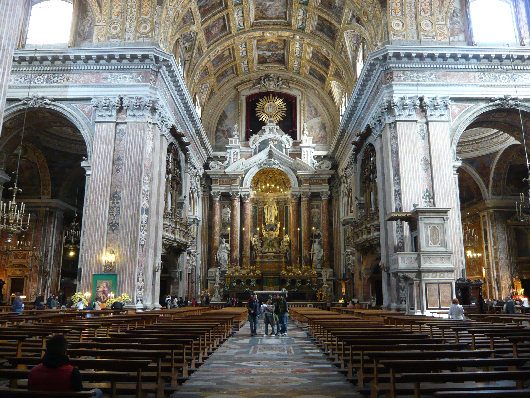
The Gesù Nuovo church is the most
important church ever built by Jesuits in Naples University of Naples
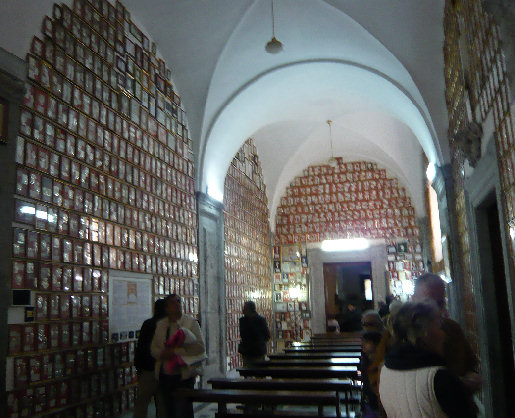
Then, it is possible to see the
chapel of Visitation. The altar-piece is the last work carried out by Massimo
Stanzione (1585-1656), unfinished and completed by a disciple of his..
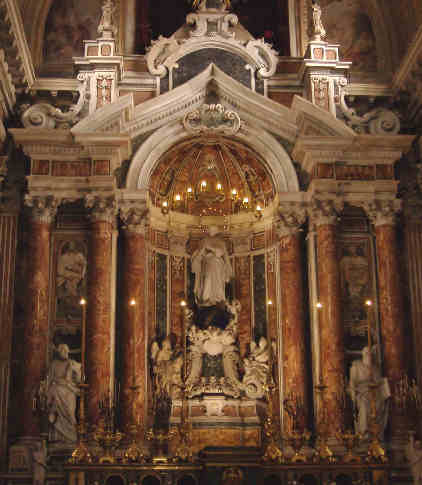
Under the altar, there is the bronze
urn containing the mortal remains of St. Joseph Moscati (1880-1927), who was canonized
on 25th October 1897 by Pope John Paul II…
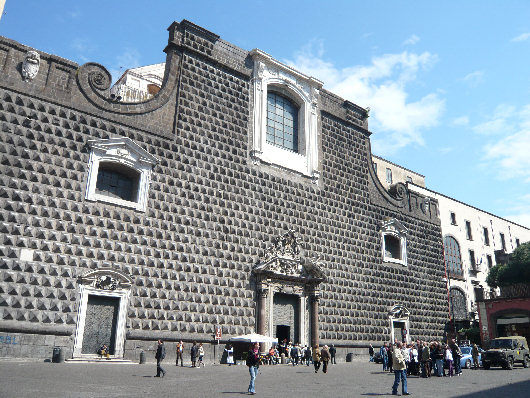
He was Biochemistry teacher at the University of Naples
and head physician at the Incurables
Hospital Palermo

The left panel represents the
Professor with his students, the one in the middle the Saint enlightened by the
Eucharist, the right one the Doctor, giving comfort to suffering and sick people
at the Incurables Hospital. In 1990, a bronze statue of the Saint, whose author
is Pier Luigi Sopelsa, was placed on the left…
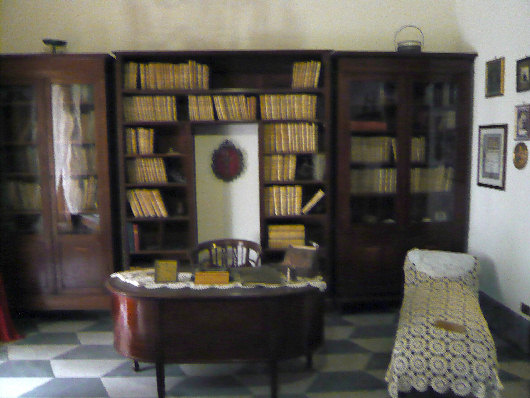
In Moscati Rooms, whose entrance is
on the left of the chapel of St. Francis Xavier, it is possible to visit some
mementos of the Saint and a row of photo showcases, which show the different
steps of his life and then the highpoints of his Beatification and following
Canonization…
 Padre Pio and Giuseppe
Moscati
Padre Pio and Giuseppe
Moscati 
Two Sons of Benevento
Finally Father Pio's sanctity has
been recognized, and this is the satisfaction of a deep and widespread desire
of million people who, already venerated the humble but great friar of the
Gargano in nearly all the parts of the world... A devotion, to Father Pio, that
spread rapidly, with a spontaneity which has something of prodigious. And it is
axactly the prodigious that characterizes this man, who, with his life, became
a "sign", just in an age which is rationalistic, misbelieving,but,
perhaps even more, indifferent to transcendent ideas…
It's the Creator's hand that wisely
kindles a sign of contradiction at the right moment, a stumbling vision that
represent a moment of reflections in a world that wildly runs along wrong ways…
Father Pio has been a sign of contradition because of his charismas that,
however, were deep in the spirituality of a man who loved Christ so much to
identify himself in his Passion with the suffering of his body… People speak so
much about miraclesm prophecies, about his power of reading within
consciencies, and perhaps they speak less about his deep spirituality, which is
put in full evidence in his voluminous correspondence…
Man is more and more interested in
the extreme, the spectacular, the inexplicable and less in a faith which is
clear, authentic and suffered and that supports the external manifestations,
destined anyway to maintain a superficial level.Perhaps this is the true goal
of the Providence,that introduces an element of attraction in a careless world,
to make people think about the essential truth,which is the real faith...
Even Peter in his Acts says that
Christ was given credit with signs, miracles anf omens among His people that ,
in spite of the great emotional attraction, condemned Him to the Cross.What the
signs didn't reach, the Holy Spirit did later in confirming the Apostles who
became the convinced supporters of a faith that still today is the only
reference point of this world, even through the Saints' witnessing…
The Christ-centric vision is the
closest contact between these two men, who touch themselves like crossed rings
but then they turn their oientation in two different directions… Father Pio, a
friar and a priest; Giuseppe Moscati, a lay and a Physician. Perhaps they
shared a peaceful character but I Think that this was related to the same
Christ-centric vision that made both of them to prefer the essential…
Confession was their most successful
number; Father Pio with that introspective vision that didn't allow any
ambguity to the penitent, Joseph Moscati who "prescribed" it even on
his book of prescriptions, convinced as he was that recovering the illnesses of
the soul helped in recoveriong the body's ones…
Father Pio, visible sign in his body
of Christ Passion, Joseph Moscati, sign of Christ invisible Passion that
modelled his spirit in the loliness of a lay world that couldn't understand the
deepness of his faith...
Father Pio, operato of signs and
miracles that made him a object of contradictions. On one side devout and
aoolauding crowds, on the other his brothers' incomprehension…
Giuseppe Moscati, without having
operated any prodigious sign in his lifetime, was oppressed by a crowd of
patients who yearned for his work as a physician.
Father Pio, still within the
boundaries of the Church and of San Giovanni Rotondo Monastery, Joseph Moscati
wandering here and there in the South of Italy, bringing also abroad the voice
of the great Neapolitan
Medical School
Both lived World War I, Father Pio
as a soldier, within the Military Hospital of Naples; Moscati as a head
physician in the Military Department of the Incurabili Hospital in Naples…
Father Pio found in Father Agostino
Gemelli an inexplicable enemy; Giuseppe Moscati, on the contrary, kindled a
great admiration in the Catholic University founder, so that he asked for his
beatification, hoping to have the possibility of putting the Saint physician
body in a chapel of the desired School
of Medicine
Giuseppe Moscati dies in his full
maturity of years, suddenly and rapidly, Father Pio dies at the age of 81 after
a long illness that made his end foreseen. Both close a historical era, even if
different in its projection… Father Pio, with his death in 1968, die at the end
of an era which is followed by the post modern era. Giuseppe Moscati dies
(1927) when the sanitary assistance is changing from charitable and
personalized to public and anonymous. Both had ended their task. Both reached
that always desired Eternity…
We have of them, beyond the signs or
the professional ability, their faith, their example, their love which in its
difference unifies and surpasses the Creature in that wide and endless ocean of
light, becoming for us human beings a sign and a recall in our earthly walk…
 Read here: Padre
Pio - “Poor friar who prays“
Read here: Padre
Pio - “Poor friar who prays“
 Read here: Padre
Pio - “Poor friar who prays“
Read here: Padre
Pio - “Poor friar who prays“
A statue made in XVI century put by Moscati in the 3rd
ward of the
Incurabili Hospital

In 2007 Italian TV-channel Rai Uno presented TV-movie
"Giuseppe Moscati. Healing Love" directed by Giacomo Campiotti. This
movie is based on testimonies of contemporaries of Moscati, who were in
acquaintance with the famous doctor. In fact this biographical movie describes
Moscati's life between 1903 when the young doctor graduated from university and
1927 when Giuseppe Moscati died...
 See here : Giuseppe Moscati - the healing love of
See here : Giuseppe Moscati - the healing love of
 See here : Giuseppe Moscati - the healing love of
See here : Giuseppe Moscati - the healing love of Giuseppe Moscati
- L'amore che guarisce 1°parte
Giuseppe Moscati
- L'amore che guarisce 1°parte S.GIUSEPPE
MOSCATI 2a PARTE
S.GIUSEPPE
MOSCATI 2a PARTE Moscati, the
healing love - part 1.
Moscati, the
healing love - part 1. Moscati, the
healing love - part 2.
Moscati, the
healing love - part 2. Moscati, the
healing love - part 3.
Moscati, the
healing love - part 3.
"Jesus my Love! Your Love makes me sublime; Your
Love makes me saint, turns me not only to a single person but to all the
creatures, to the endless beauty of all beings, created on Your own image and
likeness!" St Joseph Moscati

The bronze urn keeping the remains
of the Saint, realised by Prof. Amedeo Garufi.


Gydytojas Vargšams - Šv. Giuseppe
Moscati
Meilė yra Amžina - "Gyvenimas - tai akimirksnis.
Garbė, triumfas, turtas ir mokslas - yra trumpalaikiai. Visos gyvenimo pagundos
praeina. Mes galime tiktai Mylėti, ir tai yra Amžina - tai kiekvieno gero poelgio priežastis.
Meilė, - pergyvena mus... Galų gale, Dievas - yra meilė. Esmė - yra gimtoji Tiesa... Būkite, kuo jūs esate: be apsimetimo, be
baimės ir be žvalgymas atgal... Jei Tiesa
yra jūsų ėjimas - priimkite tai, jei kančia – visa tai iškęskite... Jei dėl Tiesos
jūs turite paaukoti save, ir savo gyvenimą - tai yra jūsų stipriausia auka... Mirtis - tai nėra pabaiga, - tai yra pradžia."
Giuseppe Moscati gimė
1880 metais, mirė 1927 metais. Katalikų bažnyčios pripažintas kaip šventasis,
kanonizuotas Pauliaus II...
Tai pirmas
pasaulietis tikintis gydytojas, kuris už savo darbus, tikėjimą ir meilę žmonėms
buvo pripažintas šventuoju...
Giuseppe Moscati
mokėsi medicinos. Baigęs, pradėjo dirbti ligoninėje, o vėliau tapo ir
vyriausiuoju ligoninės gydytoju. Jis kiekviename ligonyje matė Kristaus
atvaizdą ir atidavė visą save ligonių gydymui. Atsisakė savo asmeninio
gyvenimo, nors buvo įsimylėjęs moterį, bet jam labiau rupėjo, kaip padėti
vargšams ligoniams. Išrašydamas receptus ligoniams, duodavo ir pinigų, kad
turėtų už ką nusipirkti. Nusilpusiems vargšams duodavo ko pavalgyti. Kad galėtų
padėti vargšams, pardavė savo tėvų baldus ir paveikslus...
Neopolyje jėzuitų Gesu Nuovo bažnyčioje, koplyčios
altoriuje ilsisi šventasis Giuseppe Moscati... yra bronzinė statula - su med.
chalatu ir ant kaklo stekoskopu visų ūgiu Giuseppe Moscati statulą .. statulos
rankos labai blizga, nes žmones liečia ir bučiuoja statulos rankas...

«Do not be afraid, for your Father has been pleased to
give you the kingdom» (Luke 12,32).

"Nebijok, mažoji kaimene: jūsų Tėvas panorėjo
atiduoti jums karalystę" Luko 12,32 Biblija

Komentarų nėra:
Rašyti komentarą